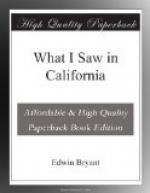CHAPTER XV.
GENERAL OBSERVATIONS UPON THE COUNTRY.
First settlement of the missionaries
Population
Characteristics of white population
Employments
Pleasures and amusements
Position of women
Soil
Grasses
Vegetable productions
Agriculture
Fruits
Cattle
Horses
Wild animals
Minerals
Climate
Flora
Water-power
Timber
Religion.
It was during the month of November, 1602, the sun just retiring behind the distant high land which forms the background of a spacious harbour at the southernmost point of Alta California, that a small fleet of vessels might have been seen directing their course as if in search of a place of anchorage; their light sails drawn up, while the larger ones, swelling now and then to the action of the breeze, bore them majestically along, forcing their way through the immense and almost impenetrable barrier of sea-weed, to a haven which, at the remote period stated, was considered the unexplored region of the North. The fleet referred to hauled their wind to the shore, and, passing a bluff point of land on their left, soon came to anchor; but not until the shades of night had cast a gloom over the scene so recently lighted up with the gorgeous rays of a setting sun.
This was the commencement, or rather preliminary mark, of civilization in this country, by the Spaniards, (if so it can be called,) and on the following morning a detachment was landed, accompanied by a friar, to make careful investigation of the long ridge of high land which serves as a protection to the harbour from the heavy north-west gales. They found, as reported, an abundance of small oak and other trees, together with a great variety of useful and aromatic herbs; and from its summit they beheld the extent and beauty of the port, reaching, as they said, full three leagues from where the vessel lay at anchor. A large tent was erected on the sandy beach, to answer the purposes of a church, where the friar might perform mass, and by directions of the commanding officers, the boats were drawn up for repairing, wells were dug, parties were sent off to cut wood, while guards were placed at convenient distances to give notice of the approach of any hostile force. The latter precaution was hardly carried into effect, ere a large body of naked Indians were seen moving along the shore, armed with bows and arrows. A friar, protected by six soldiers, was dispatched to meet them, who, making signs of peace by exhibiting a white flag and throwing handfuls of sand high into the air, influenced them to lay aside their arms, when, affectionately embracing them, the good old friar distributed presents of beads and necklaces, with which they eagerly adorned their persons. This manifestation of good feeling induced them to draw near to where the commander had landed with his




